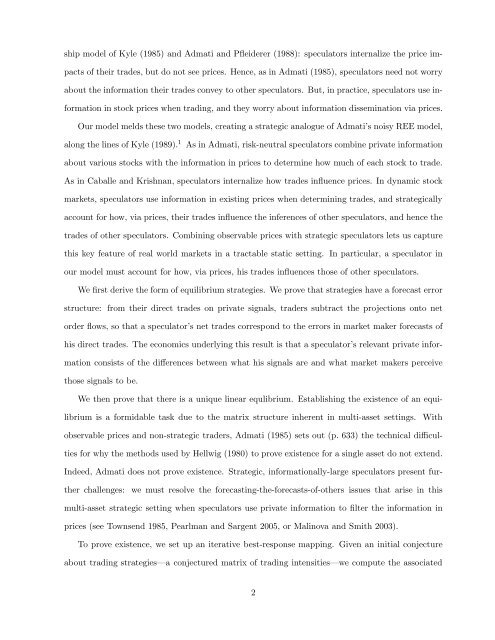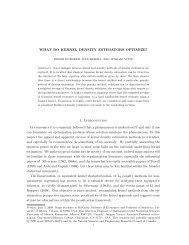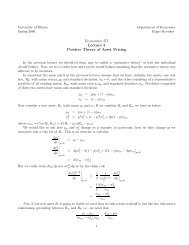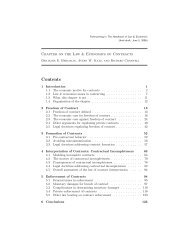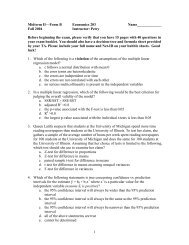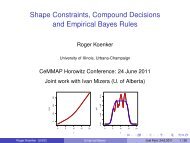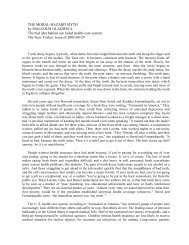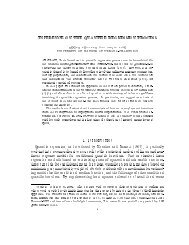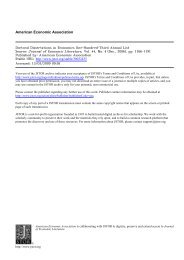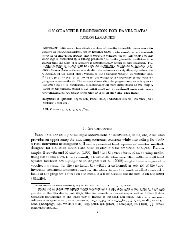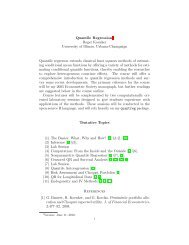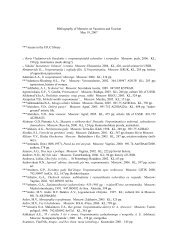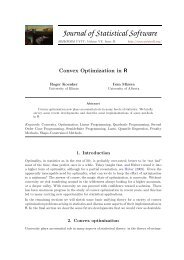Cross-Asset Speculation in Stock Markets∗ - Econometrics at Illinois ...
Cross-Asset Speculation in Stock Markets∗ - Econometrics at Illinois ...
Cross-Asset Speculation in Stock Markets∗ - Econometrics at Illinois ...
You also want an ePaper? Increase the reach of your titles
YUMPU automatically turns print PDFs into web optimized ePapers that Google loves.
ship model of Kyle (1985) and Adm<strong>at</strong>i and Pfleiderer (1988): specul<strong>at</strong>ors <strong>in</strong>ternalize the price impactsof their trades, but do not see prices. Hence, as <strong>in</strong> Adm<strong>at</strong>i (1985), specul<strong>at</strong>ors need not worryabout the <strong>in</strong>form<strong>at</strong>ion their trades convey to other specul<strong>at</strong>ors. But, <strong>in</strong> practice, specul<strong>at</strong>ors use <strong>in</strong>form<strong>at</strong>ion<strong>in</strong> stock prices when trad<strong>in</strong>g, and they worry about <strong>in</strong>form<strong>at</strong>ion dissem<strong>in</strong><strong>at</strong>ion via prices.Our model melds these two models, cre<strong>at</strong><strong>in</strong>g a str<strong>at</strong>egic analogue of Adm<strong>at</strong>i’s noisy REE model,along the l<strong>in</strong>es of Kyle (1989). 1 As <strong>in</strong> Adm<strong>at</strong>i, risk-neutral specul<strong>at</strong>ors comb<strong>in</strong>e priv<strong>at</strong>e <strong>in</strong>form<strong>at</strong>ionabout various stocks with the <strong>in</strong>form<strong>at</strong>ion <strong>in</strong> prices to determ<strong>in</strong>e how much of each stock to trade.As <strong>in</strong> Caballe and Krishnan, specul<strong>at</strong>ors <strong>in</strong>ternalize how trades <strong>in</strong>fluence prices. In dynamic stockmarkets, specul<strong>at</strong>ors use <strong>in</strong>form<strong>at</strong>ion <strong>in</strong> exist<strong>in</strong>g prices when determ<strong>in</strong><strong>in</strong>g trades, and str<strong>at</strong>egicallyaccount for how, via prices, their trades <strong>in</strong>fluence the <strong>in</strong>ferences of other specul<strong>at</strong>ors, and hence thetrades of other specul<strong>at</strong>ors. Comb<strong>in</strong><strong>in</strong>g observable prices with str<strong>at</strong>egic specul<strong>at</strong>ors lets us capturethis key fe<strong>at</strong>ure of real world markets <strong>in</strong> a tractable st<strong>at</strong>ic sett<strong>in</strong>g. In particular, a specul<strong>at</strong>or <strong>in</strong>our model must account for how, via prices, his trades <strong>in</strong>fluences those of other specul<strong>at</strong>ors.We first derive the form of equilibrium str<strong>at</strong>egies. We prove th<strong>at</strong> str<strong>at</strong>egies have a forecast errorstructure: from their direct trades on priv<strong>at</strong>e signals, traders subtract the projections onto netorder flows, so th<strong>at</strong> a specul<strong>at</strong>or’s net trades correspond to the errors <strong>in</strong> market maker forecasts ofhis direct trades. The economics underly<strong>in</strong>g this result is th<strong>at</strong> a specul<strong>at</strong>or’s relevant priv<strong>at</strong>e <strong>in</strong>form<strong>at</strong>ionconsists of the differences between wh<strong>at</strong> his signals are and wh<strong>at</strong> market makers perceivethose signals to be.We then prove th<strong>at</strong> there is a unique l<strong>in</strong>ear equlibrium. Establish<strong>in</strong>g the existence of an equilibriumis a formidable task due to the m<strong>at</strong>rix structure <strong>in</strong>herent <strong>in</strong> multi-asset sett<strong>in</strong>gs. Withobservable prices and non-str<strong>at</strong>egic traders, Adm<strong>at</strong>i (1985) sets out (p. 633) the technical difficultiesfor why the methods used by Hellwig (1980) to prove existence for a s<strong>in</strong>gle asset do not extend.Indeed, Adm<strong>at</strong>i does not prove existence. Str<strong>at</strong>egic, <strong>in</strong>form<strong>at</strong>ionally-large specul<strong>at</strong>ors present furtherchallenges: we must resolve the forecast<strong>in</strong>g-the-forecasts-of-others issues th<strong>at</strong> arise <strong>in</strong> thismulti-asset str<strong>at</strong>egic sett<strong>in</strong>g when specul<strong>at</strong>ors use priv<strong>at</strong>e <strong>in</strong>form<strong>at</strong>ion to filter the <strong>in</strong>form<strong>at</strong>ion <strong>in</strong>prices (see Townsend 1985, Pearlman and Sargent 2005, or Mal<strong>in</strong>ova and Smith 2003).To prove existence, we set up an iter<strong>at</strong>ive best-response mapp<strong>in</strong>g. Given an <strong>in</strong>itial conjectureabout trad<strong>in</strong>g str<strong>at</strong>egies—a conjectured m<strong>at</strong>rix of trad<strong>in</strong>g <strong>in</strong>tensities—we compute the associ<strong>at</strong>ed2


